Out and about
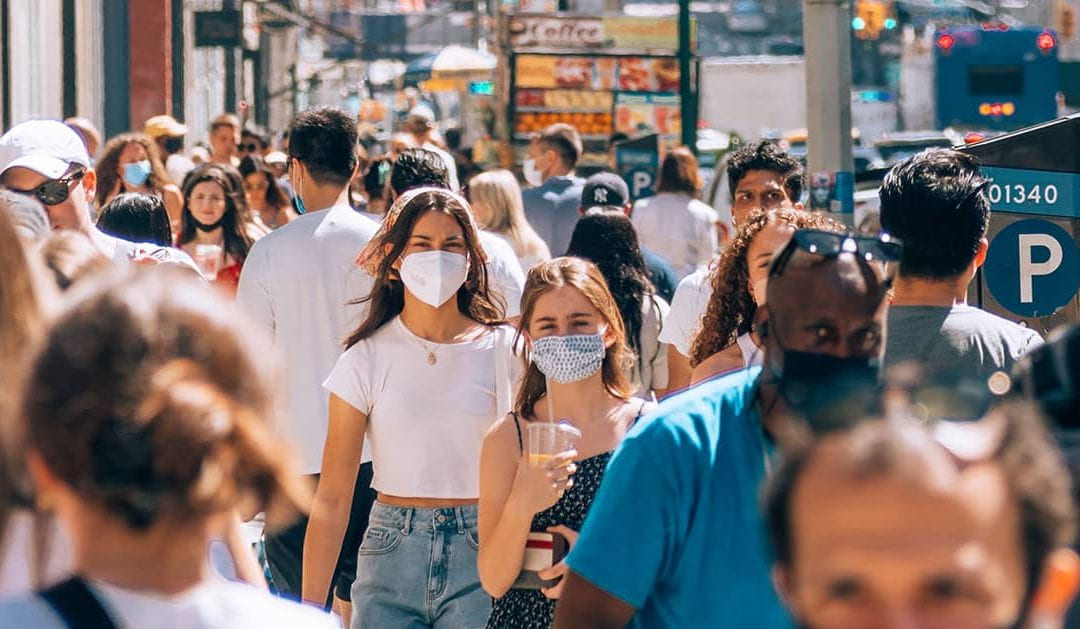
Wanting to ‘move on’ is natural – but women’s pandemic experiences can’t be lost ‘lockdown amnesia’
Header image: People wear masks on the street in Manhattan. Photo by Yoav Aziz on Unsplash.
15 January 2023
Holly Thorpe, Te Pūnaha Matatini, University of Waikato; Grace O’Leary, University of Waikato; Mihi Joy Nemani, University of Waikato, and Nida Ahmad, University of Waikato
The COVID-19 pandemic was – and continues to be – hugely disruptive and stressful for individuals, communities and countries. Yet many seem desperate to close the chapter entirely, almost as if it had never happened.
This desire to forget and move on – labelled “lockdown amnesia” by some – is understandable at one level. But it also risks missing the opportunity to learn from what happened.
And while various official enquiries and royal commissions have been established to examine the wider government responses (including in New Zealand), the experiences of ordinary people are equally important to understand.
As researchers interested in women and gender roles, we wanted to capture some of this. For the past three years, our research has focused on what happened to everyday women during this period of uncertainty and disruption – and what lessons might be learned.
Pandemic amnesia
Individual memory can become vague as time goes on. But this can also be affected by broader narratives (in the media or official responses) that overwrite our own recollections of the pandemic.
Political calls to “live with the virus”, and media hesitancy to publish COVID-related stories due to perceived audience fatigue, can create a collective sense of needing to “move on”. Looking back can be seen as questionable, or even attacked.
Indeed, misinformation and disinformation have been used, in the words of leading pandemic social scientist Deborah Lupton, to “challenge science and manufacture dissent against attempts to tackle [such] crises”.
But as the memory scholar Sydney Goggins has put it, such “public forgetting leads to a cascade of impacts on policy and social wellbeing”.
A gendered pandemic
Responding to the rapidly changing social, cultural and economic impacts of the pandemic, feminist scholars have highlighted the particular physical and emotional toll on women worldwide.
This has included social isolation and loneliness, increased domestic and emotional labour, the rise in domestic and gender-based violence, job losses and financial insecurity. Black, Indigenous, minority and migrant women have felt these impacts particularly keenly.
The same trends have been observed in Aotearoa New Zealand. And whereas some countries embraced pandemic recovery strategies that recognised these gender differences, this hasn’t been the case in New Zealand.
The gendered abuse of women leaders – former prime minister Jacinda Ardern and scientist Siouxsie Wiles, for example – have been well documented. But the experiences of ordinary women, their struggles and strategies to look after themselves and others, have had much less attention.
Experiences of everyday women
Our study involved 110 women in Aotearoa New Zealand. We set out to understand how they adapted their everyday practices – work, leisure, exercise, sport – to maintain or regain wellbeing, social connections and a sense of community.
Despite many differences between the women in our sample, there were also shared experiences. We referred to the ruptures in the patterns, rhythms and routines of their lives as “gender arrhythmia”.
The women responded to the psycho-social and physical challenges, such as disrupted sleep or weight changes, by creating counter-rhythms – taking up hobbies, exercising, changing diet.
The pandemic also prompted many to reflect on how their pre-pandemic routines and rhythms had caused various forms of “alienation”: from their own health and wellbeing, meaningful social connections, ethical and sustainable work practices, and pleasure.
The disruption of the pandemic caused many to reevaluate the importance of work in their lives. As one reflected:
COVID-19 has made me reassess what is the most important thing. Is it making money? Actually, no, not at all.
Others were prompted to question and challenge the gendered demands on women to “do everything” and “be everywhere” for everyone:
I think as women, because we’re so good at multitasking, we just put so much on our plates. I think we need to learn just to say no, because we’re not superhuman. And ultimately, all of this responsibility is weighing us down.
Our research also highlighted how the pandemic affected women’s relationships with familiar spaces and places. Leaving home for a walk, run or bike ride became important everyday practices that proved highly beneficial for most women’s subjective wellbeing.
Some came to appreciate physical activity for the general joys of movement and connection with people and places, rather than simply to achieve particular goals like fitness or weight loss.
Special challenges for young women
As part of our overall project, we also focused on 45 young women (aged 16 to 25). This highlighted the importance of recognising how gender, ethnicity and socioeconomic circumstances intersect.
Listening to their pandemic stories, we found young women played important roles in supporting their families and communities.
In particular, Māori, Pacific and others from diverse ethnic or migrant backgrounds carried increased responsibilities in the home, including childcare, cleaning, cooking and shopping. While many did so willingly, these extra burdens took a toll on their schooling, mental health and wellbeing.
For many young women, the pandemic was a radical disruption to their everyday lives and routines during a critical stage of identity development. They missed key milestones and events, and crucial phases of education and social development.
Many still grieve for some of those losses. And some are struggling to rebuild social connections, motivation and aspirations.
For example, some described being passionate and aspiring athletes before the pandemic. But social anxieties and body-image issues left over from lockdowns have been hard to shake, and have seen them struggle to return to sport.
The invisible work of migrant women
We also looked deeply at the experiences of 12 middle-class migrant women, and how prolonged border closures created real anxiety about “not being there” for families overseas.
As one nurse working on the front line of COVID care in NZ explained:
About a year ago, the cases of COVID in my homeland were increasing so rapidly. My family were not very well and I was depending on social media […] trying to reach out to them. I was really scared at that time, not being able to see your family when they really need you, not being able to be with them.
Some of the women in our sample also experienced increased anti-immigrant sentiments which further affected their health and wellbeing – and their feelings of belonging. As one said:
I’ve become extremely sensitive. I cry about small things. My doctor said “go and get some fresh air, it’s good for you” […] I went outside for a walk, and someone shouted at me, screamed at me. I got terrified for my life. How do you expect me to have wellbeing when no one in the society accepts you?
This arm of the research suggests a real need for investment in policies and support strategies specifically for migrant women and their communities in any future global health emergency.
Communities of care
A key feature of our study was the highly creative ways women cultivated “communities of care” during the pandemic. Even when they were struggling themselves, they reached out to friends and family – and particularly other women.
The majority of our participants were prompted to think differently about their own health and wellbeing, and what is important in their lives (now and in the future).
Throughout the pandemic, women have worked quietly, behind the scenes, in their families, communities and workplaces, supporting their own and others’ health and wellbeing. This invisible labour is rarely acknowledged or celebrated.
Many still feel the toll of economic hardship, violence and exhaustion. And less tangible feelings of disillusionment remain in a society that has so quickly “moved on” from the pandemic.
Acknowledging and addressing pandemic amnesia – personal and collective – is an important first step in documenting, learning from, and using these experiences to better prepare for future events. Next time, we need to ensure the necessary support is available for those most in need.
The authors wish to acknowledge the other members of the research team: Dr Nikki Barrett, Dr Julie Brice, Dr Allison Jeffrey and Dr Anoosh Soltani.![]()
Holly Thorpe, Principal Investigator, Te Pūnaha Matatini, Professor in Sociology of Sport and Gender, University of Waikato; Grace O’Leary, Research Fellow, University of Waikato; Mihi Joy Nemani, Senior Lecturer, Te Huataki Waiora School of Health, University of Waikato, and Nida Ahmad, Research Fellow, University of Waikato
This article is republished from The Conversation under a Creative Commons license. Read the original article.
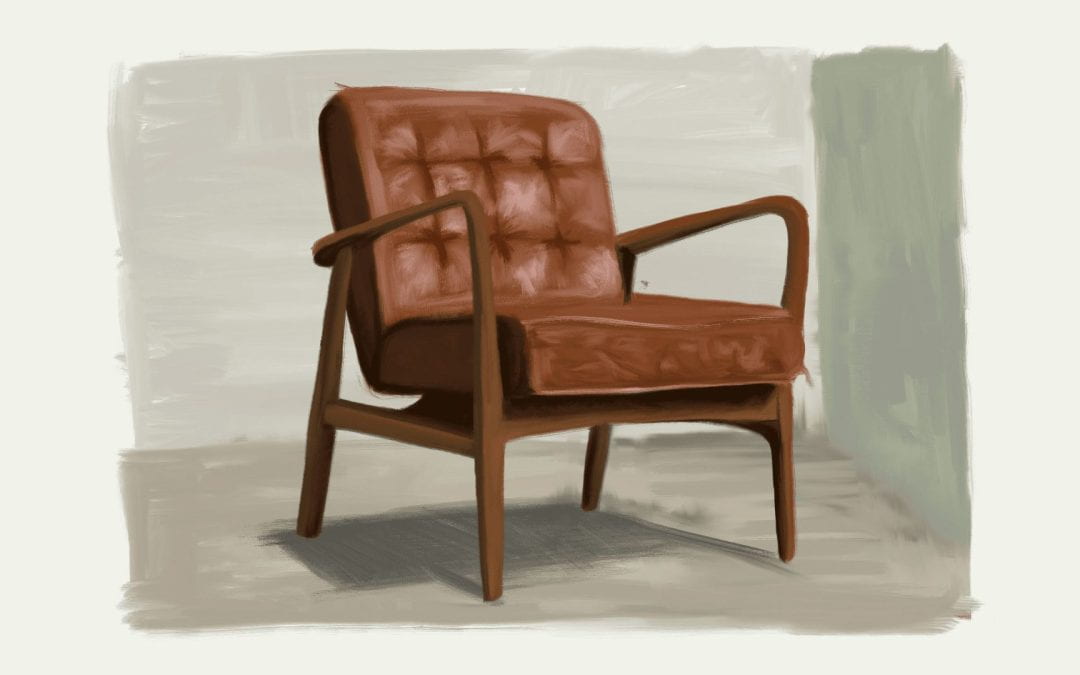
The past, the present and the future
20 December 2023
A collaboration between market analyst Hamza Ajmal and illustrator Jean Donaldson. Edited by Jonathan Burgess.
Objects are collections of essences.
I am sitting in my living room on a leather chair against a wall. The living room walls are off-white in colour with a few scratches, marks and scribbles on them. The chair is dark brown, made of leather and wood. The living room and the chair, according to the Ancient Greek philosopher Aristotle, possess unique essences derived from their materials and form. The walls are off-white, so they have an off-white essence. The chair is made of leather, foam and wood. It is formed by the amalgamation of these elements, creating the very essence of a chair.
The essences of an object have stories to tell.
According to Avicenna — the preeminent philosopher and physician of the Islamic Golden Age — the essences of an object are actually information. One can make informed inferences about an object by observing it. For example, the marks on the walls suggest movement of large objects through the living room that have hit the walls. The pencil scribbles suggest that children have played in the room. The chair has some chips and indentation in the seat, suggesting it is in a used condition, has been used for long sittings, and has been moved around.
The things that are old were once young.
Avicenna argued that when the chair was originally made, it stood untouched by the hands of time. As the days unfolded, however, information inscribed itself upon the chair — each scratch, movement, and sitting contributing to its evolving story. Each marking tells a story of the chair’s past and is not a mere imperfection. In other words, there is a relationship between information and time. As time goes by the universe increases the amount of information.
Avicenna — elaborating on this logic — argued that the world is not a collection of static things, but a dynamic flow of information across time. Instead of thinking about the future where there is more information, if we go back in time there is less and less information, and at some point, we reach a moment where there is the minimum amount of necessary information for an object to unravel itself from that moment.
The things that are soiled were once pristine.
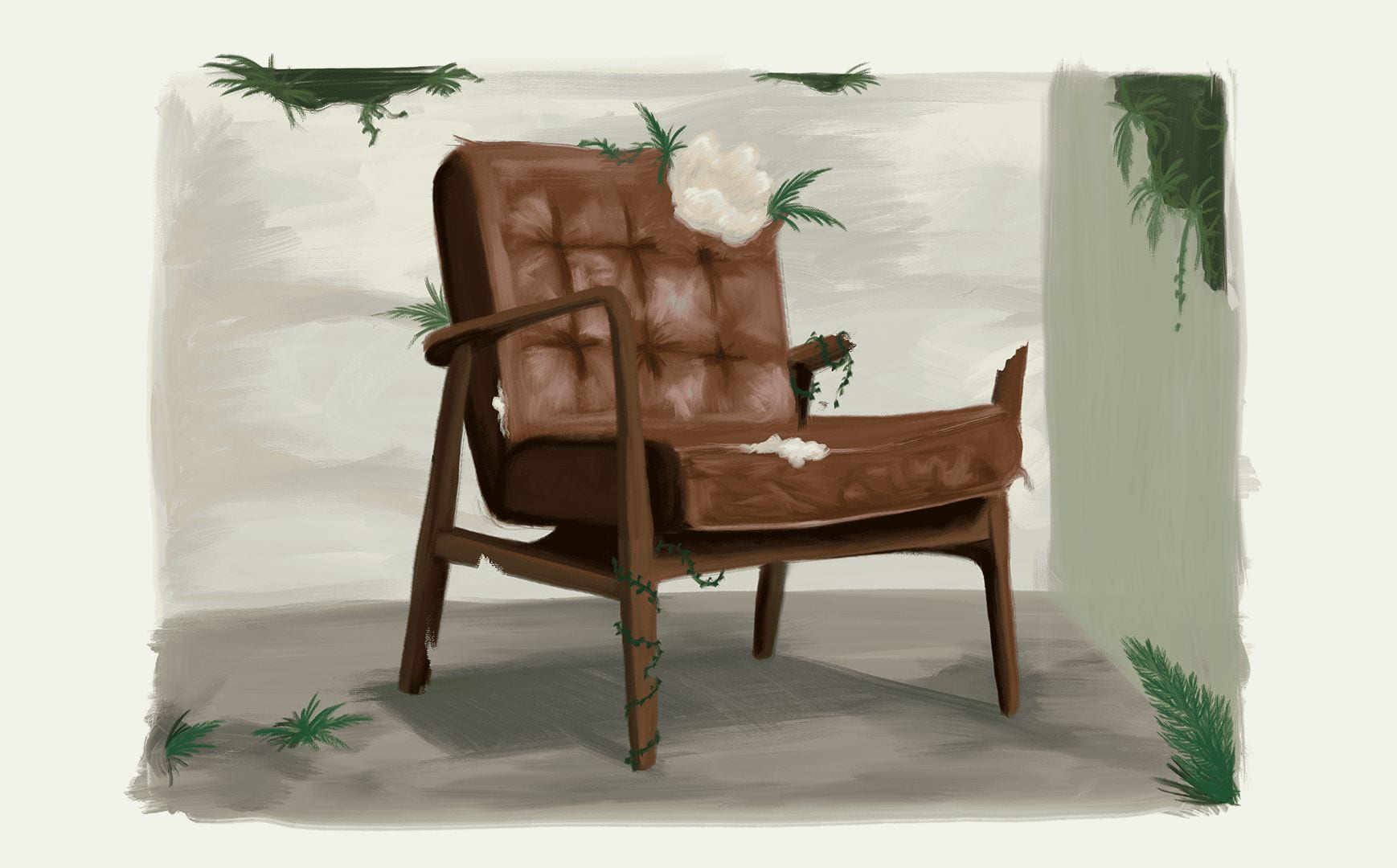
The laptop I am currently using to write is three years old. It is well maintained, and has no signs of scratches or marks. I have taken good care of it, especially after my prior computer’s unfortunate encounter with Sprite and cappuccino. Fortunately, the laptop didn’t break. However, some of the liquid dried within the keyboard. For someone who likes Macbooks for their keyboard, typing with sticky keys is a pretty awful experience.
The markings on an object are results of actions.
Over the last few years, my newsfeed has become more and more rife with climate catastrophes, the endangerment and extinction of species, and potential threats to human survival. A part of my work is to observe and forecast external factors that can have an impact on New Zealand and the world economy. The climate pattern El Niño is appearing increasingly frequently amongst these factors.
Among the various risks associated with El Niño, global food security is a significant concern. For New Zealand, repercussions of extreme weather events are multifold, ranging from economic disruption to loss of life. A recent manifestation was Cyclone Gabriele in early 2023, the aftermaths of which are still lingering across the country and will continue to do so for some time. If we view the environment as the walls of my living room, the current state of my living room is a direct result of past actions.
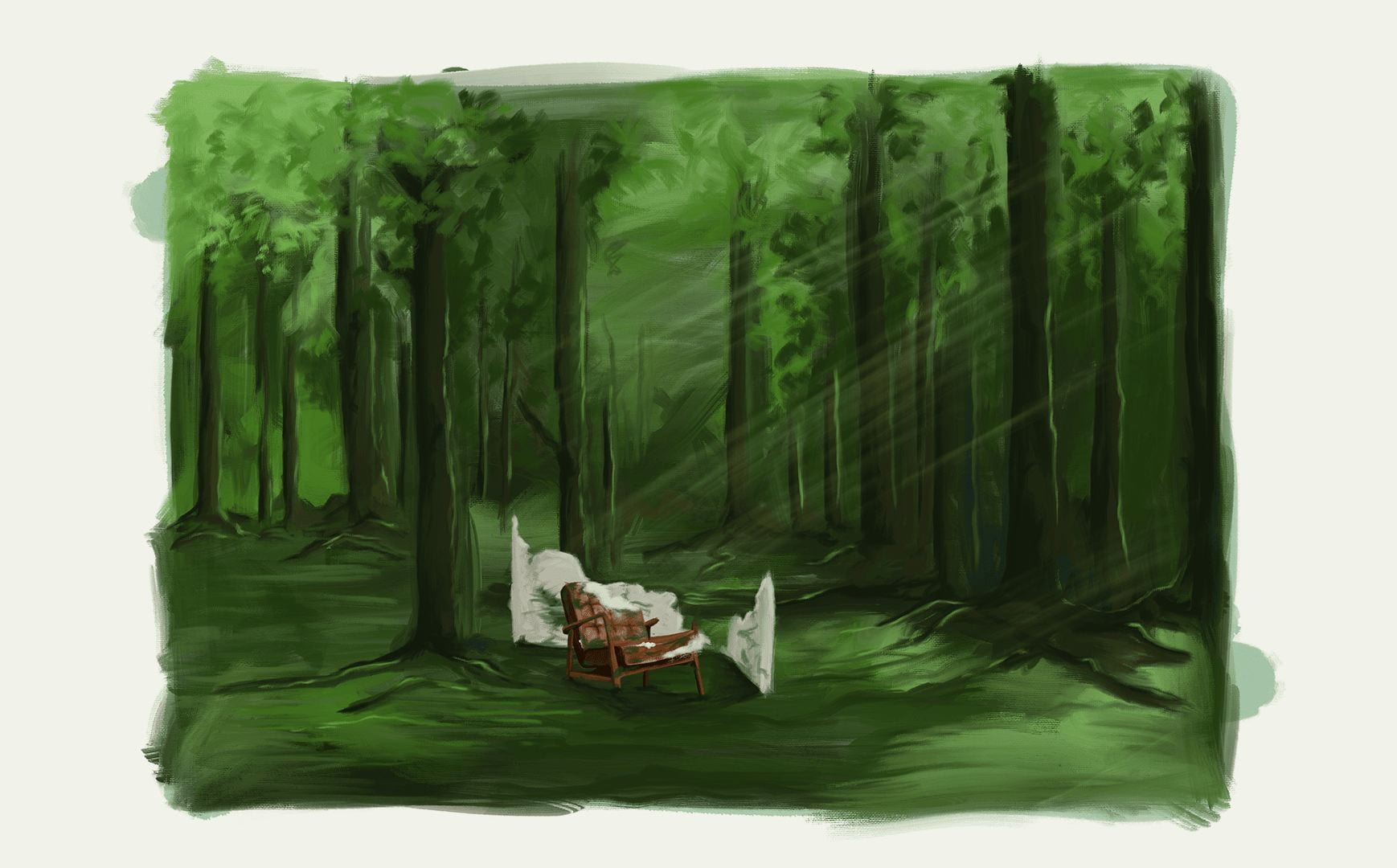
Kia whakatōmuri te haere whakamua.
In Māori philosophy the conceptualisation of time does not leave the past behind; one carries one’s past into the future. These concepts are similar to the philosophical narratives of Aristotle and Avicenna that things are connected with time. If we seek to put things back in order, maybe it is a wise idea to revisit the past — where there are less and less markings on our environment — and learn from the practices of our ancestors that lived in harmony and connection with their environment.
I walk backwards into the future with my eyes fixed on my past.
Hamza Ajmal is a principal investigator with Te Pūnaha Matatini who researches in the areas of finance, economics, and sustainability.
Jean Donaldson is a designer and illustrator who works with Toi Āria: Design for Public Good. She is based in Te Whanganui-a-Tara. You can see more of her work at https://jeanmanudesign.com/.
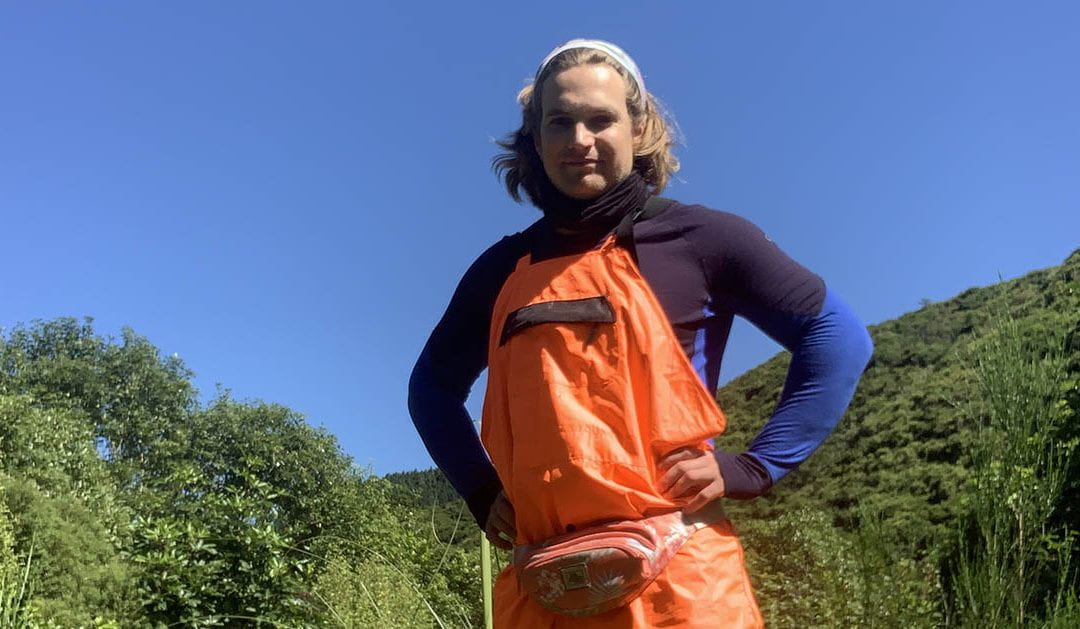
How can we ensure landscape-scale ecological restoration outcomes over time?
7 December 2023
After his recent fieldwork, Henry Morse had almost 9,000 photos of plants on his phone.
Henry has been collecting data on how ecological restoration sites have been regenerating over time, to contribute to his PhD in landscape ecology and ecological restoration. He recently received seed funding from Te Pūnaha Matatini to employ two research assistants to assist with his fieldwork.
Ecological restoration aims to recreate, initiate or accelerate the recovery of an ecosystem that has been disturbed. The sites that Henry has been researching are diverse. They are of different ages, different sizes and different locations. Some are surrounded by urban landscapes, some by suburbs, and others by farmland.
Along with his research assistants Paul Bell-Butler and Faustine Cabanne, Henry completed vegetation surveys at sites across the lower North Island of Aotearoa New Zealand, using transects. Transects are straight lines that cut through a landscape so that standardised measurements can be made, tracked over time, and compared to other areas. This will give him a full census of the seedlings, saplings and older trees at each site, and allow him to assess whether regeneration is processing well or being stunted.
Each site took around a day to survey, and half a day afterwards to process all the data — logging huge numbers of plant identifications and measurements, and turning those thousands of photos into usable data.
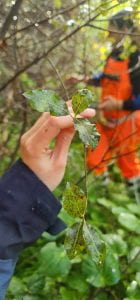
Image: One of the thousands of plant identification photos taken by Henry and his research assistants.
At the moment, ecological restoration in Aotearoa is largely driven by motivated individuals. “There are a lot of individual landholders that are interested in ecological restoration,” says Henry. “Some have land that is too steep for crops, or so boggy that they lose stock in it. Restoring degrading hillslopes can prevent further loss of that area, and restoring a bit of wetland on a farm can save the cost of having to pay for losing stock each year.”
“Other people simply have a passion for restoration.”
For ecological restoration to have real benefit, it needs to move beyond these farm-scale projects run by individuals to broader landscape-scale projects. Henry’s overall PhD project is looking at what species to plant, where to plant, and why to plant for landscape-scale restoration. In the first chapter of his thesis, he looks at species distribution models under climate change futures, to get an idea if what we’re planting in restoration projects makes sense for the long term.
The data from this fieldwork will inform the second chapter on how restoration sites are recovering, based on their place in the landscape. “Regeneration sites within a certain proximinity of a seed source might show good diversity and abundance,” explains Henry. “So they might need less effort than another site.”
This analysis will be used to strategise restoration on a landscape-scale. Planting is labour-intensive and expensive, so this research will be useful to prioritise where to plant, and what can be left to regenerate on its own. “Natural regeneration is probably going to be the primary powerhouse behind getting regeneration going on the landscape scale,” says Henry.
In the final chapter of his thesis, Henry will explore different landscape-scale restoration scenarios. “If we were to restore five metres alongside every major waterway, what would the impact on the ecosystem be?” asks Henry.
Henry is originally from Los Angeles. Once he has completed his PhD, he wants to continue working in the Aotearoa research system. “The ecological research that’s happening here is amazing,” he says.
“The cutting edge of where ecology is going now is being led by mātauranga Māori. Even though it’s not what I’m working on, just being in the proximity of that feels awesome.”
And if there is a restoration site or group near you, Henry encourages you to get involved. “They can really use the support, and it does so much for your mental health.”
“Or just simply walk off the trail,” says Henry. “Wander around a little bit and get a feel for your local ngahere. It’s awesome.”
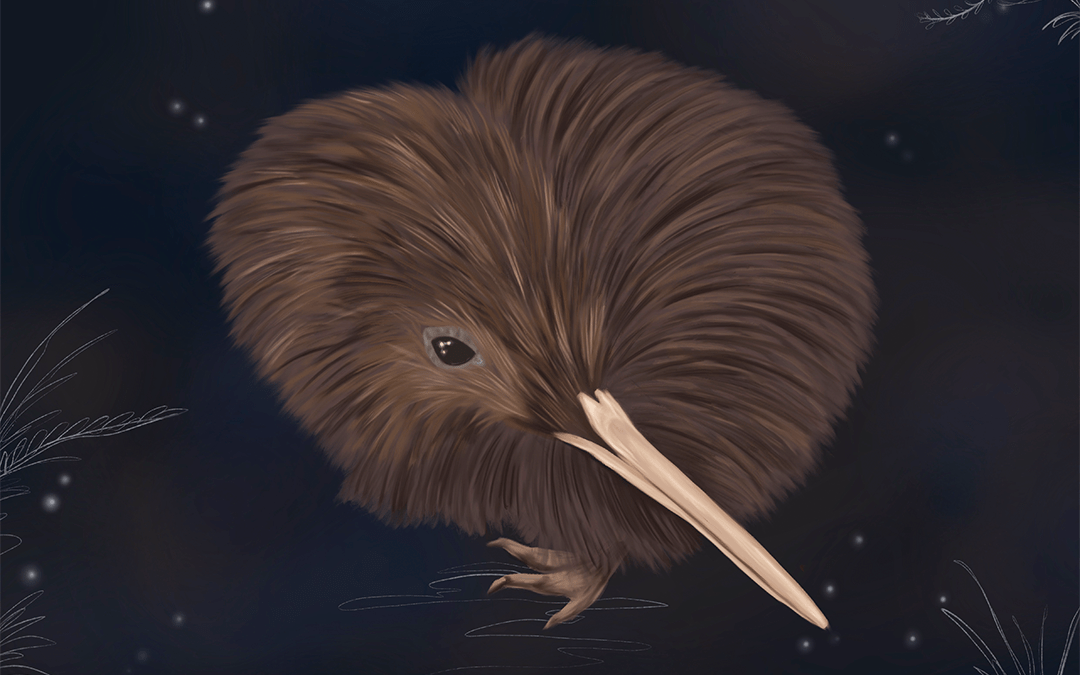
The night time world of the kiwi
4 December 2023
A collaboration between wildlife biologist Isabel Castro and illustrator Jean Donaldson. Edited by Jonathan Burgess.
Kiwi are a group of five extant species of birds endemic to Aotearoa New Zealand. Their bodies are rounded, and they have a long bill that curves down at the end of a long neck. They belong to an ancient group of birds at the base of the avian tree of life. They have tiny wings that are useless for all intents and purposes, but a very large brain for a bird. Their brain is large due to the enlargement of several of the areas needed for cognition (innovative feeding, social behaviour, and vocal learning) and integration of information.
Kiwi are nocturnal. They are active during the dark hours and rest in burrows or hideaways during the daytime. Being nocturnal poses many challenges. They have very small eyes, but a highly-developed sense of smell — something that can be used in the dark to get information about their surroundings, especially other animals.
I always encourage my students working with kiwi to try to become a kiwi by sitting in the darkness of a moonless night on the forest floor. I ask them to close their eyes and take some time to adjust to the darkness, inside and out. We must close our eyes as our sense of sight is so strong that having them open would interfere with other sensations.
The sense of touch becomes important when one cannot see. Feeling the air and the cold around bare patches of skin — especially the face and hands — can help with navigation, social interactions, and gathering weather information. By listening to the sounds around us we can identify animals moving in the understory, mosquitoes approaching, and the song of the nocturnal species like ruru allows us to know about other kiwi, predators, and parasites.
I ask them to smell the air, and ask what is in it. What plants can they recognise? Animals? What can they say about their environment as they use their senses like kiwi? When they get up, can they walk safely? What would they need to walk?
After a few tries, a person can distinguish between the noises made by rats, mice, donkeys, sheep, kiwi, other birds roosting in the trees, insects, and other humans when walking in the bush. They can also detect the presence of streams by their sounds and tell the height of the canopy by listening to the wind on the tops of trees. Smelling is not as easy, but we can easily smell the flowering plants in an area, wet soil, and many smells brought in by the wind — many we cannot identify. We can walk aided by a stick or by placing our arms outstretched. The easiest is going on all fours!
Although not confirmed, I imagine that kiwi use their large brain to form mental maps of what is in their environment. I think it could be like having a map or GPS that allows them to move safely around as long as things stay in the same place. In case something drops on to the forest floor, or moves, they use their tap-ahead behaviour, where they touch the ground in front with their bill as they move, to make sure they do not trip on things. In addition to using air movement around their body, sounds and smells, this would allow kiwi to have a pretty good picture of what their area is like.
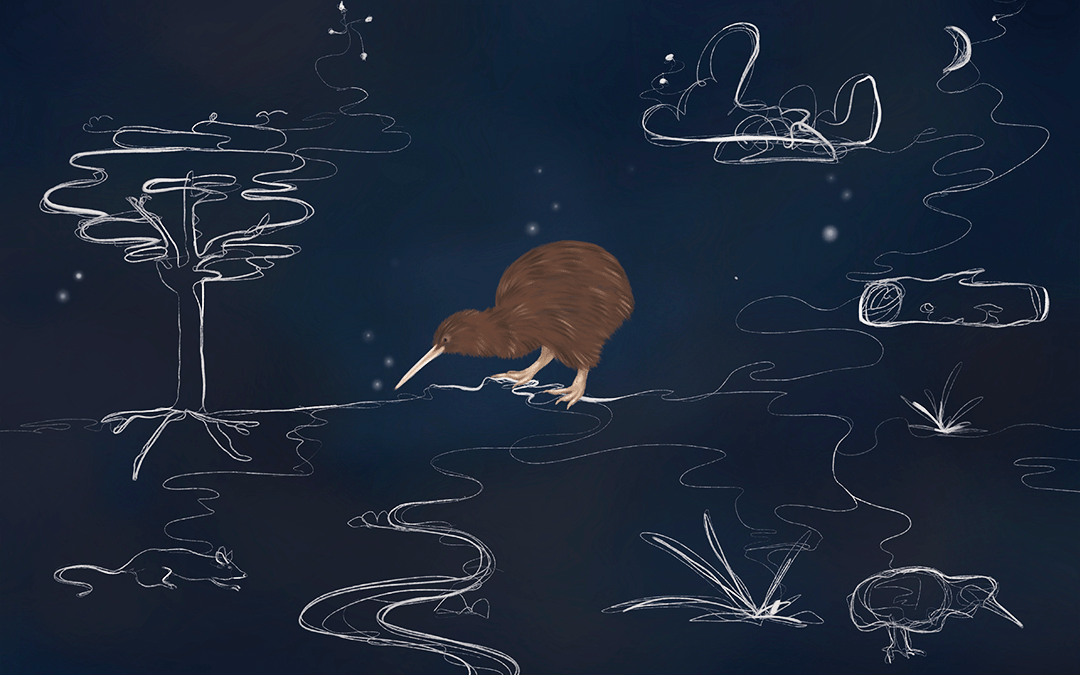
By touching obstacles with their bill, kiwi can also update their mental maps by adding new obstacles. When a tree or a new plant falls on the forest floor, many kiwi in an area come to it and for the first few days of falling they have a heightened interest in it. I think this allows them to add it to their map.
When we were studying the foraging behaviour of kiwi my PhD student Susan Cunningham and I would find a kiwi in the darkness of the night while walking around with a low light head torch and would stop to video him or her using infrared technology.
We recognised the kiwi because of two main bits of information they provide while out at night. Firstly, they looked like a dark basketball (their body) with a bright white stick (their bill) in front of the ball. The reason why the bill is so prominent in the dark is unknown, but it could be possible that it reflects light in a special way that makes it more visible. That way kiwi could find each other by looking at the whiteness of each other’s bills.
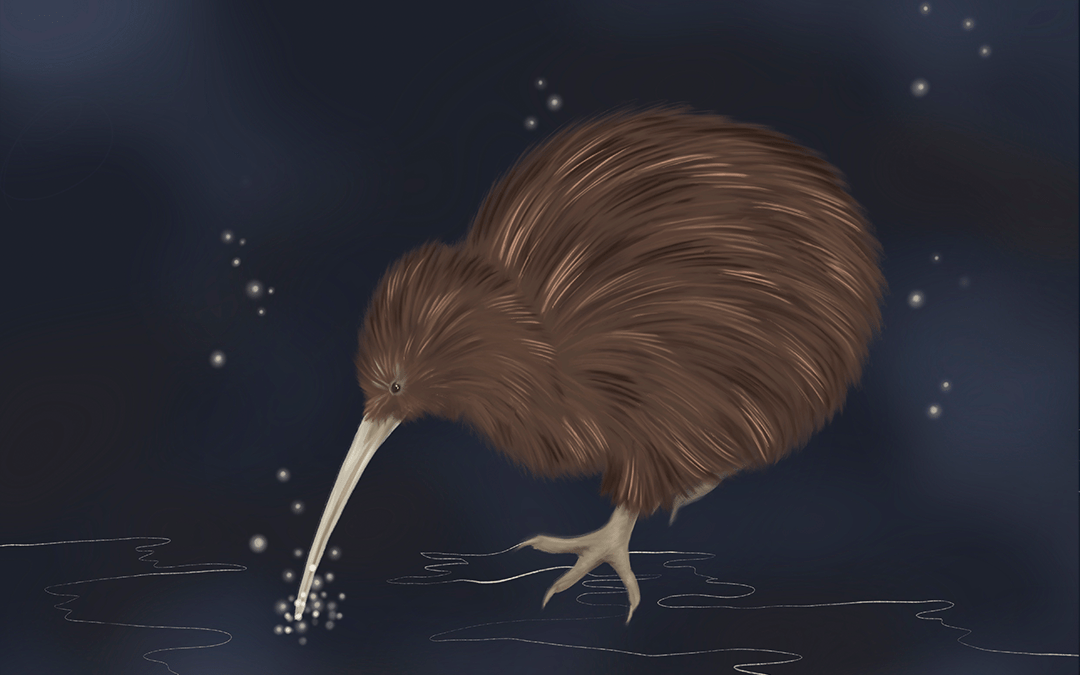
The other giveaway is their extremely noisy movements — especially in the middle of a dry spell when the understory is crunchy underfoot. Kiwi are so noisy one could think it is a human walking around!
Once we stopped, we would start to video their behaviour. Invariably, the bird would be at least ten metres away from us, but as time went by they would get closer and closer while seemingly indifferently smelling in our direction. We took it that they were interested in us and our presence and approached to check us at a range that would allow a better understanding of what we were. If we moved and made a sound or coughed or cleared our throats, they would run a short distance away and start the process again.
While kiwi can call and they have different sounding calls for males and females (and possibly individuals), they only call on average about once per night. We found that pairs and groups that nest together tend to be within earshot of each other’s movements and I wonder whether these close-range sounds are used to know the position of the members of their social group.
I imagine that this would be like recognising the walking pattern of a familiar person. It would be super interesting to record such sounds and see whether individuals have specific identifiable patterns.
Isabel Castro is a principal investigator with Te Pūnaha Matatini who researches how an animal’s biology and behaviour affect its conservation status.
Jean Donaldson is a designer and illustrator who works with Toi Āria: Design for Public Good. She is based in Te Whanganui-a-Tara. You can see more of her work at https://jeanmanudesign.com/.
Special thanks to Professor Stephen Marsland, who co-leads the Ponui Island Kiwi Research Programme, David Chamberlin and family who own our study site and are members of our team, and the many postgraduate students who help us discover amazing facts about kiwi.
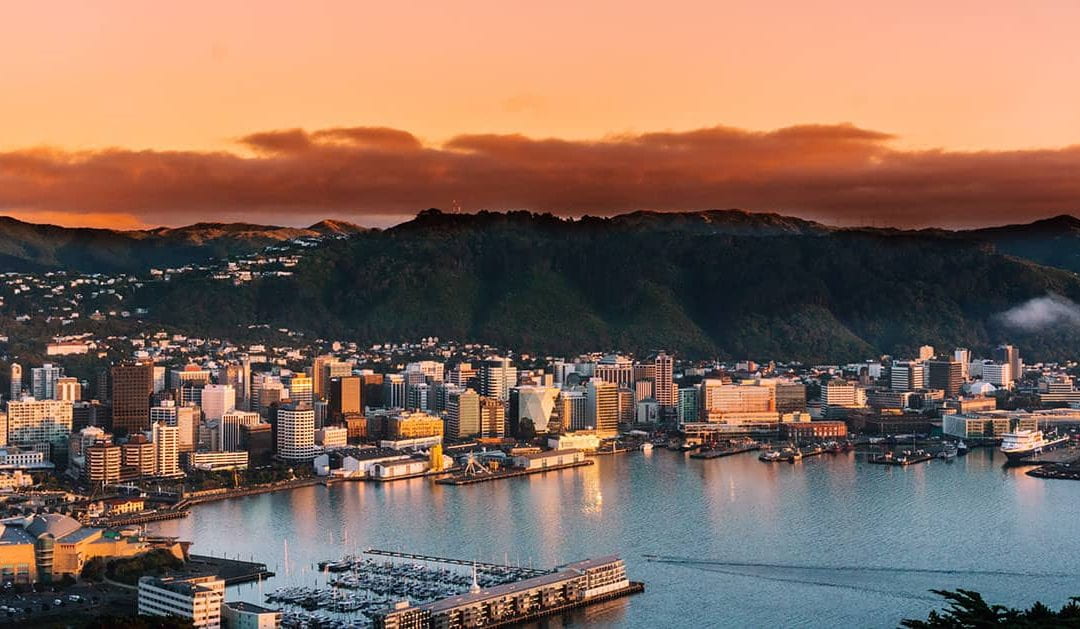
Capital City Complex Systems Symposium 2024: Call for abstracts
23 November 2023
The call for abstracts for the Capital City Complex Systems Symposium 2024 has been extended to Friday 1 December 2023.
Thank you to everyone who has registered for the Capital City Complex Systems Symposium 2024. We’re really looking forward to seeing you in Te Whanganui-a-Tara in February to kōrero all things complex systems, share knowledge, and build new collaborations.
We have lined up an exciting list of international keynote speakers and are now inviting abstract submissions for contributed talks, lightning talks, and posters.
Talks will be given 15 minute slots (12 minutes presentation + Q&A). Poster presentations will also include a short mini-presentation (no Q&A) to advertise the poster, followed by a poster reception to facilitate in-depth discussions with symposium attendees.
If you would like to present at the symposium, we’re asking for a short abstract (max 250 words) on complex systems, network science, and their applications by the 24th of November.
Abstracts will be reviewed by the programme committee for rigour, significance and suitability, with a focus on balancing the programme diversity with thematic groupings and synergies.
Submission deadline (extended): Friday 1 December 2023
Notification of acceptance: Friday 15 December 2023
Submit an abstract for the Capital City Complex Systems Symposium 2024 – Google Forms
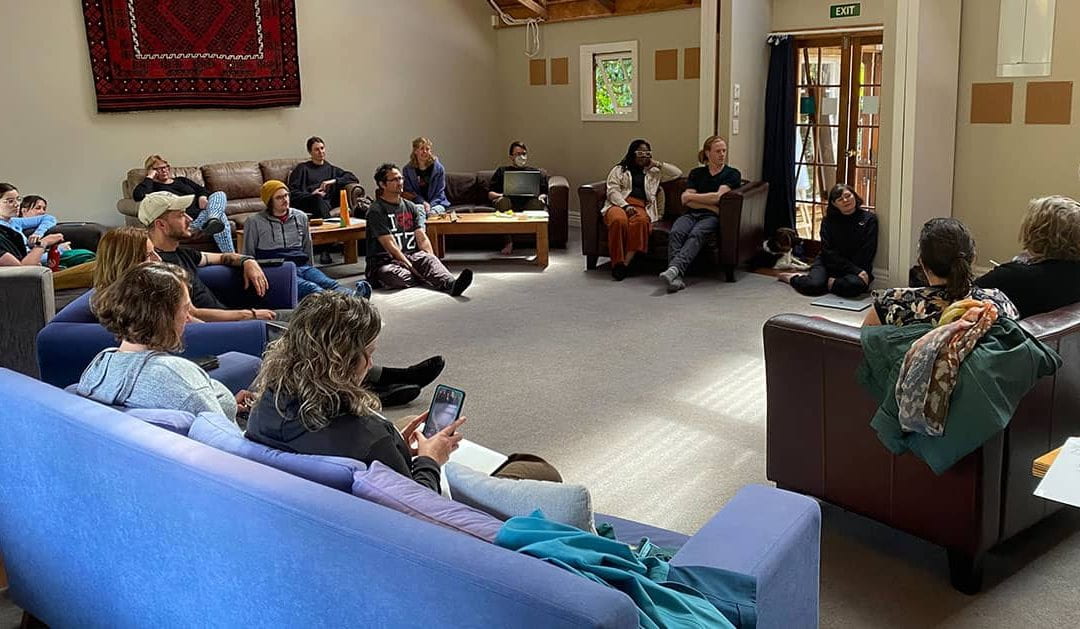
Learning to effectively engage with policymakers
15 November 2023
Te Pūnaha Matatini recently held a wānanga to develop our capacity to engage with policymakers about our research.
The workshop was led by Te Pūnaha Matatini Principal Investigators Dr Shaun Hendy, Associate Professor Rhian Salmon and Jo Bailey, and Communications and Marketing Senior Adviser Jonathan Burgess.
Eighteen Te Pūnaha Matatini principal investigators and TPM Whānau participated in the wānanga. Over three days, they explored the relationship between research and policy, gained insights into effective communication of research for policy, and learned strategies for supporting evidence-informed decision-making.
Shaun shared his knowledge of the theoretical underpinnings of research-policy engagement, how research and policy operates in Aotearoa New Zealand, case studies of important examples of research-policy interaction in Aotearoa and internationally, and his immense personal experience in engaging with policymakers.
He analysed how research and policy had interacted about issues such as methamphetamine residue in Housing New Zealand homes, the Fukushima nuclear accident, the botulism scare in milk powder, 90-day employment trials, and the Covid-19 response in Aotearoa.
The workshop was enlivened by the hands-on activities created by Jo, in which participants built their dream policy tool out of cardboard, and collaborated to build a paper network of policy relationships sourced from the participants in the room.
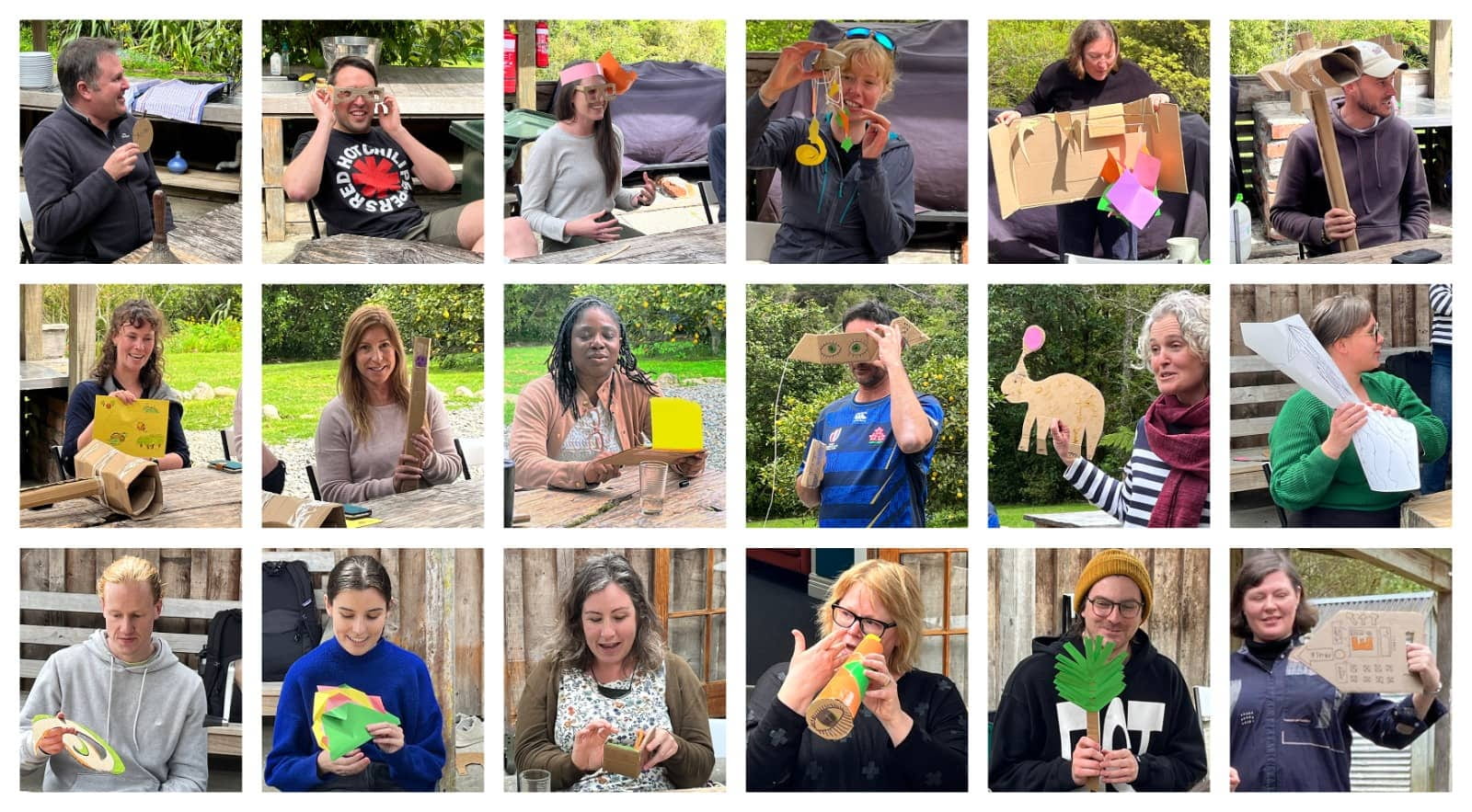
Image: Research-policy engagement wānanga participants build their dream policy engagement tool.
Jonathan took all the participants through a guided exercise to draft a policy brief based on issues identified by their research. An expert panel of Dr Christina Hood, Philippa Yasbek and Dr Sarah-Jane O’Connor visited the wānanga to share their extensive experience of working with research and policy.
TPM Whānau member Angela Davies is undertaking doctoral research on education institution data as a source of sustainable competitive advantage. She particularly appreciated the group size, which meant that “each of our needs have been identified and addressed along the way”.
Te Pūnaha Matatini Principal Investigator Céline Cattoën-Gilbert works as a hydrological forecasting scientist at NIWA. She found the atmosphere of trust at the wānanga “refreshing and empowering” and enjoyed the balance of presentations, practical activities, discussion and rest.
Alongside their draft policy briefs, all participants left the workshop equipped with a next action to take to improve their engagement with policymakers. The collective experience over the three days of the wānanga also created a support network for all the participants to draw on as they engage with policymakers about their research.
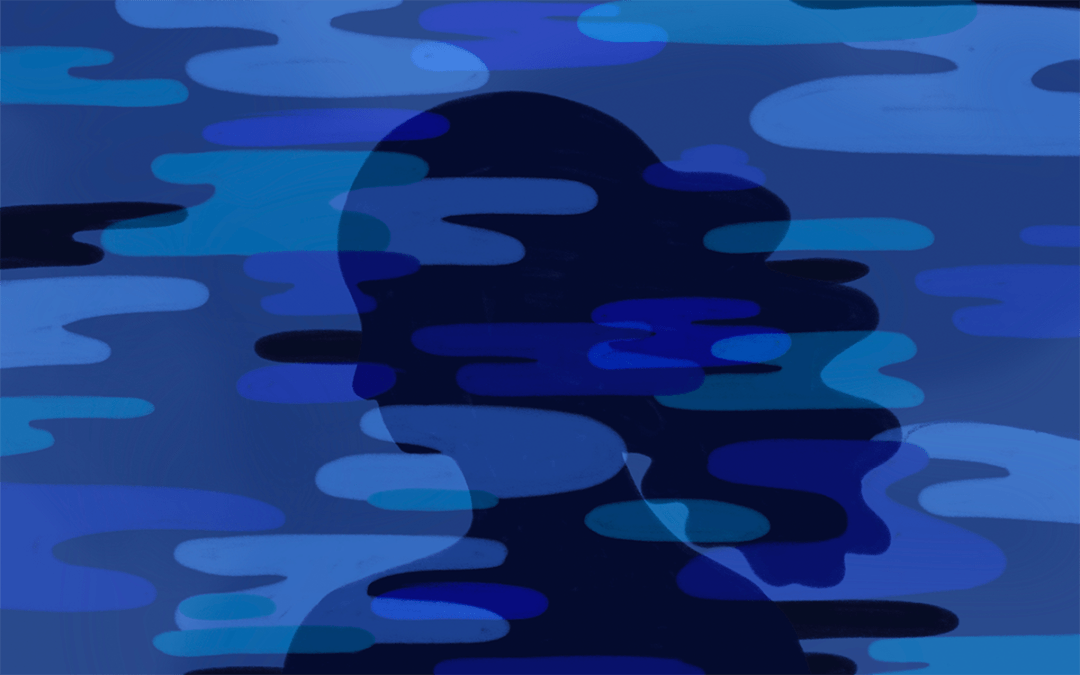
The invisible glue holding families together during the pandemic
7 November 2023
A collaboration between sociologist Holly Thorpe and illustrator Jean Donaldson. Edited by Jonathan Burgess.
Aroha* turned 16 just one week before the first nationwide lockdown in Aotearoa New Zealand. Before the arrival of Covid-19 on our shores, she had been focused on school, sport and having fun with her friends.
During the first lockdown, Aroha willingly moved from part-time to full-time work at her local supermarket to help her family out with the bills. Both her father and older brother had lost their jobs, so she had offered to increase her hours.
Initially, she enjoyed going to work because it was an opportunity to get out of her crowded home and to see some of her friends. But as time went on, she saw the strain of the pandemic on her community. She recalls being verbally abused by shoppers taking out their stress on young workers, and this seemed “really unfair”, particularly when such attacks left some of her co-workers in tears in the tearoom.
After work, she would walk home, take her uniform off at the door, and immediately put it in the washing machine — trying to limit the possibility of bringing the virus into her home. She was particularly worried about her 85-year-old grandmother, but also her mother, who had a serious heart condition. After a full day of work and washing her uniform, and having a quick play with her young nieces and nephews who were staying with them too, she retired to her bedroom to catch up on her school work.
At times, exhaustion took over and she fell asleep on her bed. Other times, the distraction of social media called. Aroha felt bad about spending so much time on her phone, but it was a way to connect with her friends, whom she missed deeply. Sometimes it was TikTok, Instagram, Netflix or YouTube that would absorb her entirely for the next few hours.
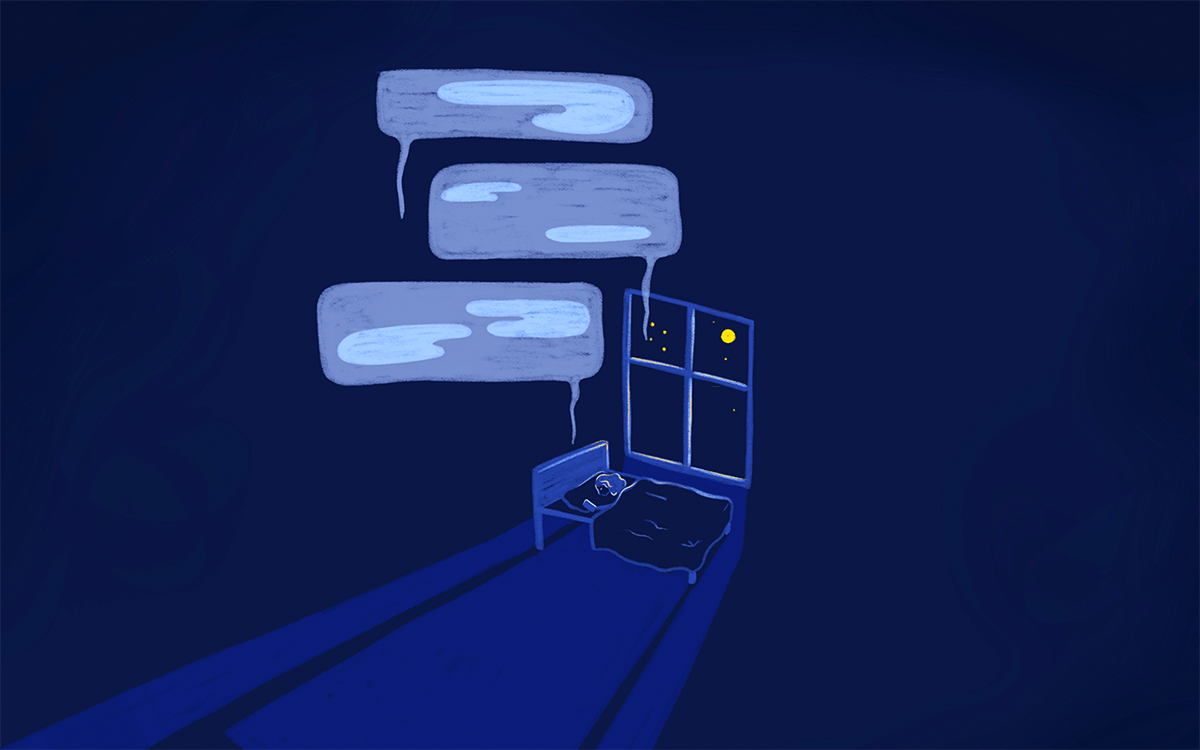
While social media helped her to escape from the stress of pandemic life, she felt bad that she wasn’t keeping up with her school work. Before the lockdowns, she’d been in the top teams for netball and touch, and was training for an upcoming waka ama competition, but all of this was cancelled. While she understood why, Aroha was sad to miss out on these important events.
***
Young women played important roles in supporting their families and communities during the Covid-19 pandemic. Aroha was just one of the 45 young women that we interviewed about their experiences during the pandemic. Overwhelmingly, these young women “stepped up”.
Young women, particularly Māori, Pacific and those from diverse ethnic and migrant backgrounds, carried increased responsibilities in the home, including childcare, cleaning, cooking and shopping. Our multicultural research team found that the weight of the pandemic did not fall evenly on the shoulders of young women; gender, ethnicity, and socio-economic factors combined to impact young women’s pandemic lives differently.
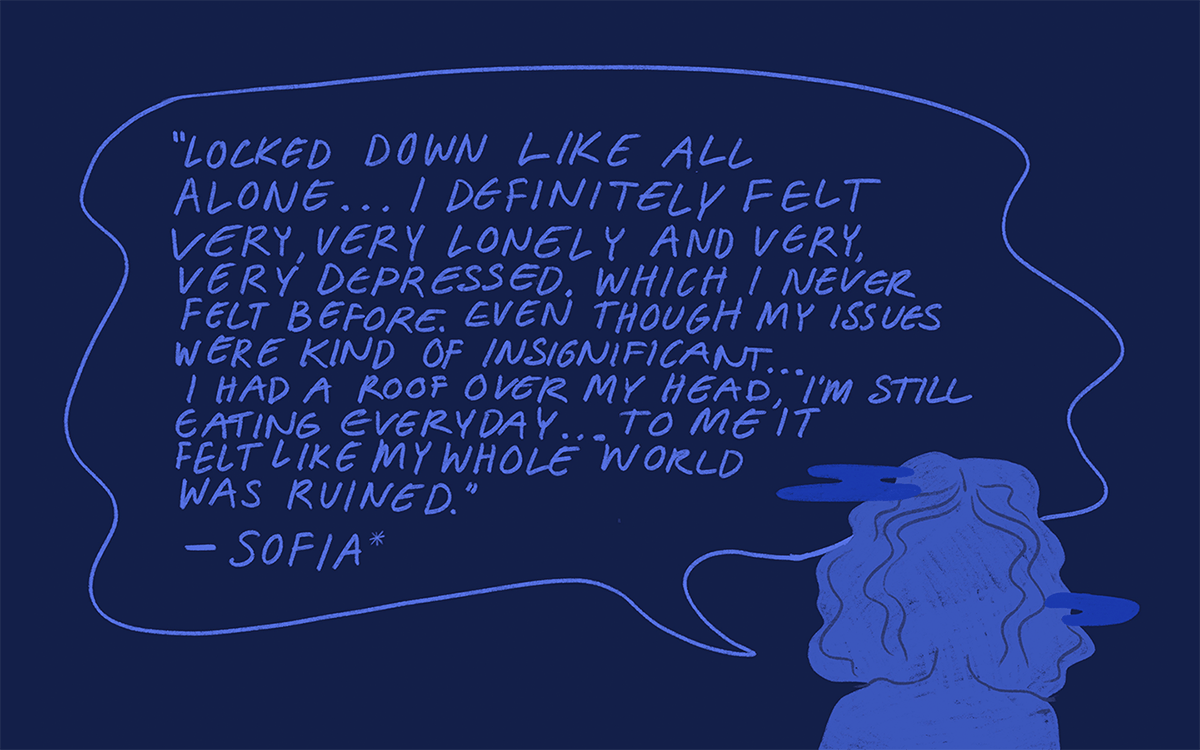
Young women were forced to grow up quickly, often taking on adult responsibilities in the home, the workplace, and their communities. While many did so willingly, this ‘double burden of care’ took a toll on their schooling, mental health and wellbeing.
Young people are now back to school, sport, and socialising with their friends, but the pandemic took a significant toll on many young women. Even after the lockdowns ended, many young women spoke of increased social anxieties, body image concerns, a loss of confidence in their educational and sporting skills, and new questions about their futures.
The radical disruption to their everyday lives and routines during a critical stage of identity development, prompted young women like Lady* to “question the future [because] you don’t really know what’s gonna happen”. Feelings of uncertainty for the future impacted upon their everyday motivation, their feelings of hope, and social connection.
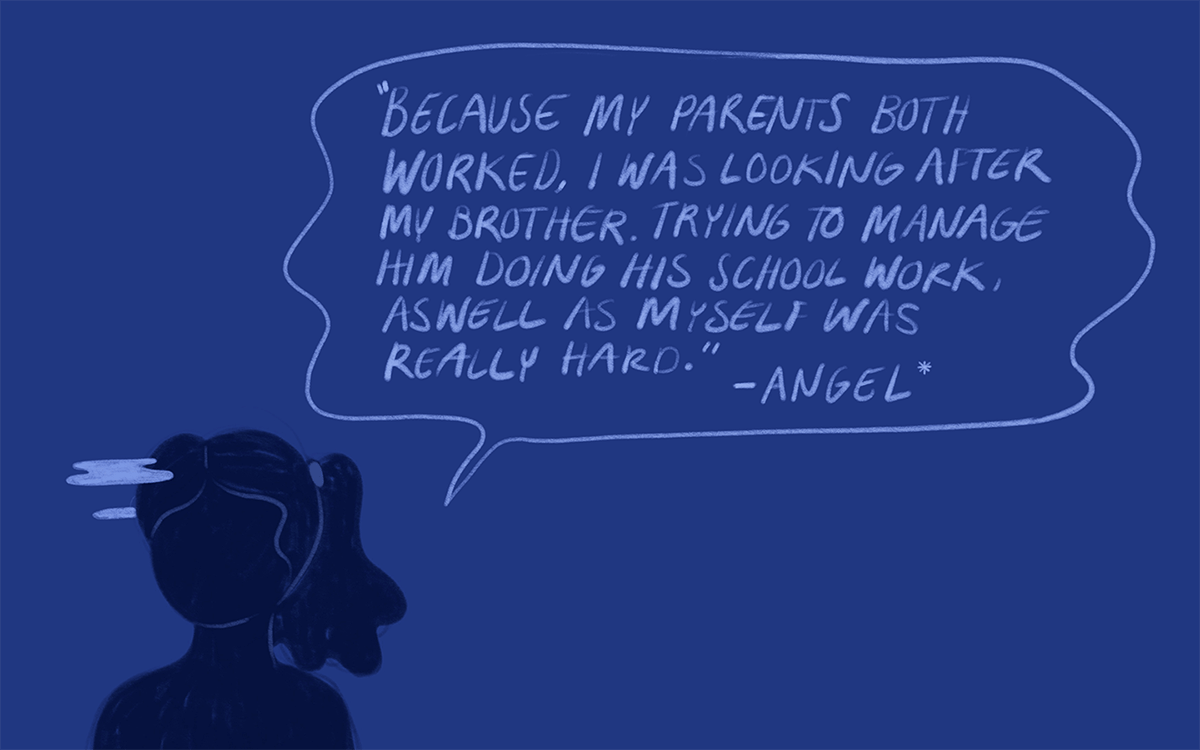
Young women took on new roles and responsibilities at home, at work and in their communities. They missed key milestones and events, and critical phases of social development. Many young women continue to grieve some of these losses, and continue to struggle rebuilding social connections and aspirations. Young women were often the invisible glue holding families together, but they rarely received the credit they deserve for their efforts during the pandemic.
In a context where many want to close the pandemic chapter entirely, it is sometimes hard to see, or to speak to, the challenges experienced by our young people during this difficult time in our families, communities and collective history. But for many young women, the emotional toll of the pandemic continues to be carried today.
There is a need for greater acknowledgement and empathy for the challenges young women have gone through over recent years, and the additional support some may need to get back on their feet.
*Names have been changed to protect the privacy of research participants.
Explore the research behind this post
Holly Thorpe is a Principal Investigator with Te Pūnaha Matatini and a recipient of a Royal Society Te Apārangi James Cook Research Fellowship focused on women’s wellbeing during and beyond the Covid-19 pandemic.
Jean Donaldson is a designer and illustrator who works with Toi Āria: Design for Public Good. She is based in Te Whanganui-a-Tara. You can see more of her work at https://jeanmanudesign.com/.
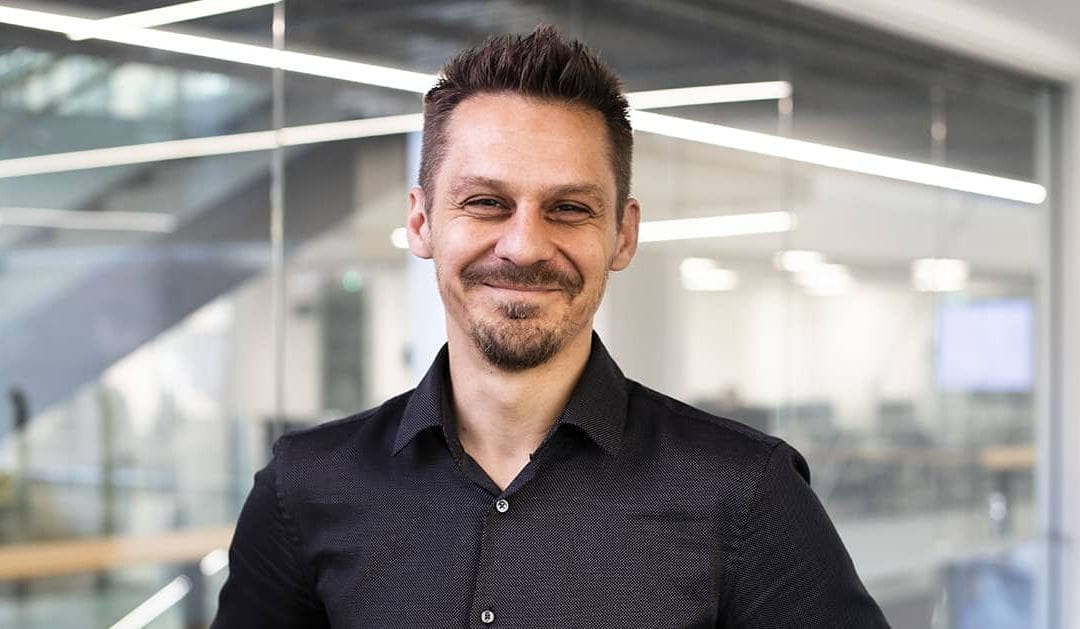
New co-director for Te Pūnaha Matatini
6 November 2023
Te Pūnaha Matatini is thrilled to announce that Associate Professor Markus Luczak-Roesch will join our leadership team as co-director from 1 January 2024. From next year, Te Pūnaha Matatini’s directorate will consist of Associate Professor Priscilla Wehi and Associate Professor Markus Luczak-Roesch as co-directors, with Associate Professor Michael O’Sullivan as deputy director.
Markus has been a part of Te Pūnaha Matatini since 2019, and has made valuable contributions at hui, workshops and through joint research projects. He is someone who cares deeply for our mandate, ambition and people.
Markus has a strong and internationally recognised transdisciplinary research profile with a focus on complex systems modelling and analysis. He is a prominent public voice in complexity science and its relevance to Aotearoa New Zealand and beyond. He founded and leads the Complexity and Connection Science Lab at Te Herenga Waka – Victoria University of Wellington, the only research lab at an Aotearoa university that is explicitly dedicated to complexity science.
“I’m really looking forward to working with Markus,” says Cilla, the current director of Te Pūnaha Matatini. “He brings a wealth of connections to international complex systems institutes that will be incredibly valuable to Te Pūnaha Matatini as we grow our relationships. And he also brings the humanity that we are known for.
“Te Pūnaha Matatini Advisory Board Chair Richard Aitken says that “it is a pleasure to welcome Markus into Te Pūnaha Matatini’s directorate. What impressed the Advisory Board was Markus’s strategic vision for the future of Te Pūnaha Matatini.”
“Te Pūnaha Matatini should become one of the world’s leading centres for complex systems research, while retaining its uniqueness,” says Markus. “What makes Te Pūnaha Matatini unique amongst international complex systems research centres is its grounding in Te Tiriti o Waitangi and te ao Māori, both of which embed a longitudinal and humanistic perspective into the science of complex systems and networks.”
“Together, we have a clear vision for the future,” says Cilla. “I look forward to working with Markus and Mike towards our joint vision for the future of Te Pūnaha Matatini.”
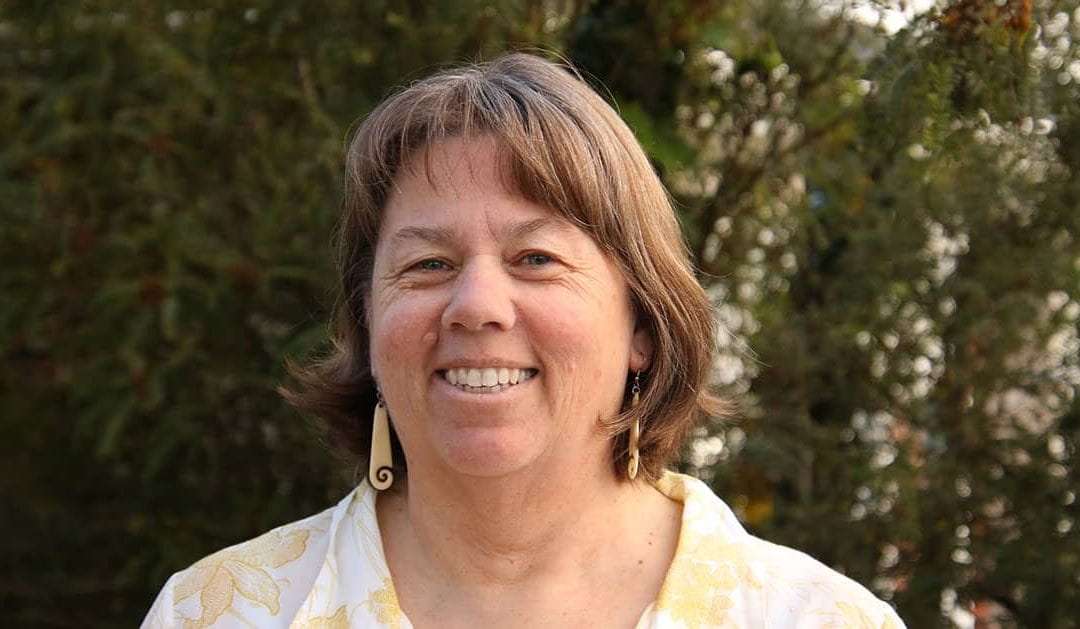
Three new partners for Te Pūnaha Matatini
Image: Director of Te Pūnaha Matatini, Associate Professor Priscilla Wehi, is excited to welcome three new partners on board.
30 October 2023
Te Pūnaha Matatini is thrilled to announce that it has partnered with three new institutions: NIWA, Toha and Cawthron Institute. This enlarges Te Pūnaha Matatini’s network of partnerships to fifteen institutions across Aotearoa New Zealand.
All three of these new partner institutions have an environmental focus, which clearly demonstrates the direction that Te Pūnaha Matatini, the Aotearoa New Zealand Centre for Research Excellence in complex systems, is moving in.
Director of Te Pūnaha Matatini Associate Professor Priscilla Wehi is excited to welcome these new partners on board. “We value the thought leadership of our new partners,” says Cilla. “Their approaches to both the culture of research and engaging with communities align very much with our own.”
“Their researchers bring a wealth of experience in transdisciplinary research and approaches such as mātauranga Māori, freshwater systems and nature based solutions, which will bring depth and innovation to our future research.”
NIWA, the National Institute of Water and Atmospheric Research, is a Crown Research Institute that conducts leading environmental science to enable the sustainable management of natural resources for Aotearoa New Zealand and the planet.
Dr Rob Murdoch, Deputy CEO of NIWA, said that “NIWA is pleased to become a partner with Te Pūnaha Matatini, as the environmental issues we deal with are some of the most complex and critical issues of our time. Our principal investigators will benefit from new collaborations and approaches in their areas of remote sensing, flood forecasting and the marine food web. We look forward to developing improved solutions in the light of increasing extreme events across the atmosphere, freshwater and marine domains.”
Toha is working to bridge the gap between finance and environmental action. They have developed the infrastructure to allow regenerative outcomes to be reliably measured, quantified and traded in the market. They are convening a network to accelerate the flow of impact investment into frontline nature-based solutions to climate change with urgency and scale.
Chief Science Officer and Co-Founder of Toha, Dr Shaun Hendy, says that “The Toha Network is very pleased to partner with Te Pūnaha Matatini. As an organisation, we are both a consumer and producer of high-quality research, but this new collaboration with the leading minds in complex systems research represents a levelling up for us.”
Cawthron Institute is Aotearoa New Zealand’s largest independent science organisation. They deliver world-class science that helps to protect the environment and support the sustainable development of primary industries in Aotearoa New Zealand and worldwide.
“Cawthron Institute was eager to join Te Pūnaha Matatini as a partner to enable our researchers to collaborate on complex and transdisciplinary research that addresses the critical challenges we’re facing in Aotearoa New Zealand,” says Chief Science Officer, Dr Cath McLeod. “There is a strong alignment of values and objectives between Cawthron and Te Pūnaha Matatini, making partnership a natural fit. Cawthron is committed to delivering research that creates a better future and we know that fostering collaboration and connection across Aotearoa New Zealand’s research, science and innovation system is critical to achieving that vision.”
All three partner institutions have researchers that are affiliated with Te Pūnaha Matatini as principal investigators, and we look forward to seeing the innovative research that comes out of these partnerships.
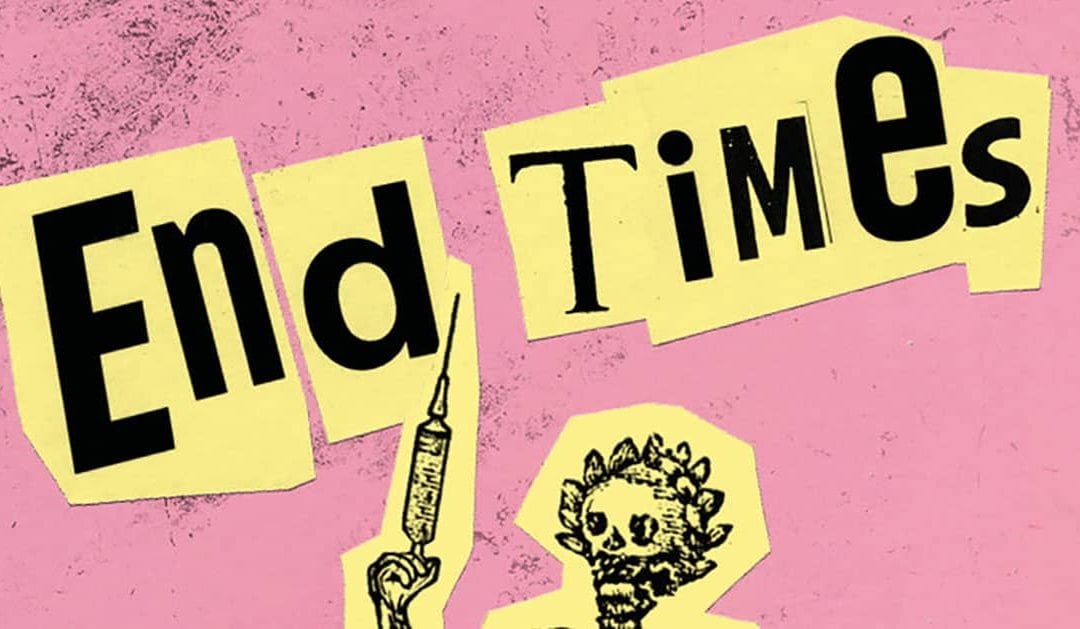
‘You know Granity is falling into the sea, yeah?’
4 October 2023
An excerpt from Te Pūnaha Matatini Principal Investigator Rebecca Priestley’s forthcoming book End Times.
‘You know Granity is falling into the sea, yeah?’ says Maz.
I look past the row of houses that separates the highway from the stony beach, and nod. As sea level rises, some coastal towns are making plans to retreat, to move buildings, walkways and roads inland, and let the sea do its thing to the coastline. In Granity, there’s nowhere to retreat to. It’s home to about 160 people living on a tiny strip of land between the steep-sided hills and the encroaching sea. As you head inland from the highway, there’s the row of houses, the railway line, then the hills. We drive past St Peter’s Anglican church – I am the way the truth and the life: Jesus says a sign – and the Granity Judo Club and then a startling display on an unhitched trailer. A life-sized naked female figure, with large round breasts and no hair, reaches her arms high above her head to hold – or throw? – an angry-looking baby. Orange flames reach as high as her raised elbows. Beneath the flames are the words GLOBAL WARMING. The placement of figure and flames, and the fierce look on the woman’s face, give the impression she is about to hurl the baby into the flames, but I doubt that’s what’s intended.
At the north end of Granity, we park on a gravelly verge and walk over a mound of earth. There’s a pīwakawaka flitting about and gulls circling over the grey-green water. I walk south along the steep beach, which is covered in rounded pebbles of speckled granites and diorites. The sections backing onto the beach all have barriers. There are fences made from driftwood, others of traditional wood and wire mesh, one with fancy gabion baskets, and one concrete block. Further along the beach, a stretch of houses is protected by a long pile of sandy coloured boulders, a rock revenant or riprap. There’s a gentle roar of the ocean, a constant reminder that the tide is coming in. One section, lower than the others, has no fence. The sea has washed a river of stones and huge bleached logs over what used to be the lawn and up around the house.
I walk until I reach a tumble of broken concrete and mangled reinforcing wire. It’s impossible to tell what it used to be. A sea wall? A pier? Remnants of an earlier civilisation; the concrete and iron age. I take some photographs then turn back towards Maz, who’s sitting in the distance, hood up, looking down at her phone. A black-backed gull flies low over the waves and a yellow glow of morning sun starts to appear through grey clouds. As I’m looking at the sky a wave surges up the beach towards me. I run but the foaming water seeps through my boots to wet my socks. I shout out – ‘Maz!’ – but she can’t hear me above the tumble of rocks being dragged back by the undertow.
I join her, laughing now, and we look along the beach, to where a digger and three people in orange hi-vis are working. There are works planned here – a news article says the government has promised funding for a seawall between Ngakawau and the north end of Granity. Locals, though – one of those interviewed describes the town as being populated with ‘rednecks and creatives’ – are asking about the rest of Granity. The seawall will protect only five houses, three of which already have rock barriers.
An oystercatcher pecks at the sand, and I think of food. It’s 11:43am – high tide isn’t for another three hours.
We drive south to Waimangaroa, where we saw a sign earlier – Fresh homemade pies cooked daily. It’s an outdoor café, with a food cart and a few picnic tables next to some sort of post-apocalyptic sculpture garden. It’s been a busy summer, the woman in the food cart tells us when we ask how business is going. We’re aware things have been tough for the Coast, which relies on tourist dollars, and are happy to be spending our city folk salaries here. We order tea and pies – chickpea and pumpkin for me, steak and cheese for Maz – then go for a wander. The sculpture garden contains derelict machinery, wooden carvings and vegetation. A man called Woody makes the art, we’re told. We pass a rusted-out truck, a tractor, larger-than-life human figures carved with tā moko on faces and buttocks, driftwood carvings behind glass screens. Under a corrugated iron roof is what looks like an ancient waka. Beneath and between the sculptures the garden is wild with ponga, nīkau, grasses and pond life. We come back smiling, buzzing. We find a place to sit, and nod a greeting to a man sitting at the next table.
‘Where’re you ladies from?’ he asks. Auckland and Wellington, we say, then Maz tells him she used to live in Westport and they have the conversation in which they identify people they know in common. Things have changed on the Coast since Maz left, he says. House prices have doubled in the last few years. ‘People are asking crazy prices for West Coast houses, and they’re selling.’
We talk about COVID-19, the vaccine rollout, and the new variants we’re starting to hear about. ‘I probably won’t take the vaccine for a while,’ the man says. ‘I’m not really into it.’
The woman from the food cart delivers our tea, a big pot of English breakfast with the kind of floral bone-china cups and saucers my Nanna used to have. She tells us her daughter is vaccinated ‘homoeopathically’, and neither she nor her daughter are going to ‘take’ the COVID-19 vaccine. She knows someone whose kid nearly died after a vaccine – he had an allergic reaction. It’s put her off, she says.
I listen, and nod, but when the man starts to query whether the Pfizer vaccine is really a vaccine, ‘since it changes your cells’, my respectful and curious listening reaches its limits. ‘I’m going to do a little plug,’ I say. ‘It is a vaccine. And it had been tested on millions, if not billions, of people by the time it got to New Zealand.’
He agrees there’s a lot of misinformation out there. ‘We’ve had the leaflet drops. They say it’s going to pre-programme you to die,’ he says. ‘Will you guys take it?’
‘Absolutely,’ we both say.
‘Are you guys nurses?’ asks the woman.
‘No, but we’re both science-trained,’ I say.
‘Personal choice,’ she says with a shrug, and walks back to the caravan to check on our pies.
End Times will be available from all good bookshops from Thursday 14 October.
